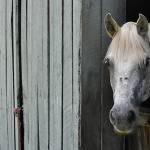Soundness in Senior Horses

Aged horses are susceptible to health problems, just as older humans are. Decreased mobility in the form of lameness is a predominant health concern of old horses. What specifically ails these horses?
The answer is likely degenerative joint disease (DJD) or osteoarthritis (OA).
“The end game of DJD and OA disease processes is clear: permanent changes to soft tissues and bones in affected joints that eventually lead to pain and inability to work,” said Kathleen Crandell, Ph.D., a nutritionist at Kentucky Equine Research.
The most obvious cause of DJD and OA in aged horses is cumulative use, whether it’s on the racetrack, in the show ring, at the riding academy, or on long trails. The concussive forces of working for years in harness or under saddle take their toll. These forces accumulate more quickly in elite-performance sports where horses are asked to perform frequently at high intensities.
“Other factors that lead to DJD and OA include genetic predisposition, cartilage abnormalities, developmental problems, poor farriery, and abnormal weight-bearing or loading,” said Crandell. At times, these predisposing factors can stack on top of one another, making a treatment plan more convoluted.
How can you take the sting out of an old horse’s step?
- Be sure your horse stands on well-trimmed or well-shod hooves, even if this means asking for an impartial opinion from a farrier different than the usual one or a veterinarian educated in farriery. Consistently poor hoof care, as an old horse might endure over multiple shoeing cycles, can contribute to joint stress and disease.
- Provide plenty of turnout for old horses and encourage them to move when they are turned out. Showing schedules often dictate that old campaigners remain stalled for much of their lives, but freedom to roam and graze is incredibly healthy for joints. Horses can be inspired to walk during turnout by placing feed and water stations far away from one another.
- Allow plenty of time for warmup and cooldown, especially for aged horses that live in stalls. Too often old horses are pulled from their stalls, tacked up, and immediately ridden off at a trot. At least 15-20 minutes of walking will help loosen stiff joints. This is especially important for horses in lesson programs. Likewise, allow plenty of time for old horses to cool after exercise before returning them to their stalls.
- Arrange for immediate care of horses that look creaky or stiff. Putting off veterinary intervention in unsound old horses might have long-lasting effects and cause more damage. Old horses can have longer recovery periods from lameness.
- Become educated about joint supplements and begin their use before signs of DJD and OA appear. Many young horses are given joint supplements, not because they have a problem, but to ward off the effects of an athletic life as they age.
Glucosamine, chondroitin sulfate, and hyaluronic acid are often given to horses diagnosed with joint disease. Research indicates that a combination of oral glucosamine and chondroitin sulfate provides more relief than giving just one of the preparations. When selecting joint supplements, choose those developed and manufactured by reputable companies, like these products from Kentucky Equine Research:
- KER-Flex, a palatable powdered formula that contains high-quality glucosamine hydrochloride and chondroitin sulfate, which minimizes wear and tear on joint cartilage;
- Synovate HA, a liquid product that delivers high molecular weight sodium hyaluronate, which contributes significantly to maintenance of cartilage health and elasticity, joint fluid integrity, and lubrication of the entire joint mechanism; and
- EO-3, a source of omega-3 fatty acids well known for their anti-inflammatory properties.
Australian horse owners should look for Glucos-A-Flex, in addition to Synovate HA and EO-3.
Work with your veterinarian and nutritionist to determine the best nutritional course for treating your old horse’s creaks. Have a question for a nutritionist? Contact Kentucky Equine Research today!








